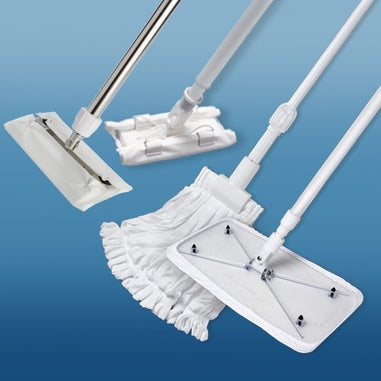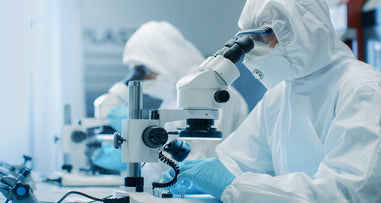- No products in the cart.
Cleanrooms are Essential for Manufacturing Medical Devices
A well-designed cleanroom is essential for the manufacture of medical devices, which are critical components of the modern-day healthcare system. Since space inside a cleanroom is limited, it is critical to know the exact specifications of personnel, equipment, workflow, and activities before construction begins. Medical device cleanrooms require additional environments for processing, cleaning, and post-processing/packaging.
Modular cleanrooms are often preferred over stick-built versions because they allow for expansion, downsizing, or relocation. Requirements for anteroom, storage, isolator, and ventilation areas for sterile (comparable to USP 797) and non-sterile HD (comparable to USP 800) cleanrooms are complex, therefore upgrades can require significant engineering considerations. Modular cleanrooms are prefabricated to exact specifications under carefully controlled conditions, while stick-built constructions require onsite fabrication.

Careful planning is needed to construct a compliant medical device cleanroom. The materials, plumbing, electrical, HVAC, entrances, and exits must be built into the design to comply with regulatory standards and function.
Whether you are upgrading your current medical device cleanroom or building a new unit from scratch, contact the experts at Lab Pro who specialize in supplying state-of-the art medical device and cleanroom manufacturing equipment and supplies.
Medical Device Classes
A medical device helps healthcare professionals prevent, diagnose, or treat a medical condition. The FDA authorizes medical devices for marketing under three different categories per The Medical Device Amendments of 1976 Act to protect consumer from microbes and contamination.
- Class I devices, like bandages and analog stethoscopes, are lower to moderate risk and require general controls.
- Class II devices require special controls, as they are moderate to high risk, such as infusion pumps and electronic stethoscopes. These devices typically require a 510(k) formal review application.
- Class III devices are high risk and support or sustain human life. Examples are automated external defibrillators or breast implants. These devices require a PMA application for approval.
Cleanroom Classes for Medical Devices
ISO 13485 (Quality Management Systems) requirements apply to all classes of medical device manufacturers. Medical devices are manufactured in Class 100-100,000 (ISO 5-8) cleanrooms, while packaging is conducted in Class 10,000 (ISO 7) cleanrooms. Plastic injection molding can take place in a Class 100,000 cleanroom. Class 10,000 cleanrooms often have dedicated gowning rooms.
Class I-II medical devices must be manufactured in Class 10,000-100,000 (ISO 7-8) cleanrooms. Class I cleanrooms to not require a Quality Management System, but some facilities follow higher standards to prevent particle contamination.
Cleanroom Layout Septic (USP 795) Processes
- Non-classified locker room area
- Classified gowning/anteroom (Class 100,000/ISO 8) cleanroom entrance
- Primary (Class 10,000/ISO 7) – assembly and packaging of low particle count/terminally sterilized devices, cell culture support devices
- Cleaning room
- Post-processing and product exit
Cleanroom Layout Sterile/Aseptic (USP 797) Processes
- Non-classified locker room area
- Classified gowning/anteroom (Class 100,000/ISO 8) cleanroom entrance
- Primary (Class 100/ISO 5) – manufacturing/assembly
- Sterile gloves and sterile single use cleanroom coveralls, hoods, gloves, and booties (shoe covers)
- Only sterile HDs may be stored within sterile area and never on the floor
- Cleaning room
- Post-processing and product exit
Hazardous Drugs (USP 800)
- Unpack HDs in negative or neutral pressure room (no positive pressure anteroom)
- Separate storage of non-hazardous and HDs
- Storage of HDs at negative or neutral pressure, external ventilation, and at least 12 ACH, containment for spills
- Primary (Class 100/ISO 5) – manufacturing/assembly
- No storage of non-sterile chemicals in sterile area
- Chemical resistant gloves, goggles, and aprons
Medical Device Cleanroom Construction
Selecting an expert in cleanroom construction can streamline installation. Once the blueprints are completed, construction of the HVAC system can begin. Pharmaceutical-grade filter units are integrated to maintain particulate compliance. Next the floor track is laid out. A double wall is assembled to allow for air return. Return air chases allow for dirty air to be exhausted. More chases are needed for lower particle count classes. For a septic process, the Class 10,000 cleanroom has the highest pressure so that no dirty air from the other areas enter. Room pressure decreases as the particle count requirements become less stringent.
As the rooms are assembled, an ultrasonic cleaning station is installed by a plumber in the cleaning area. A separate room partition can reduce moisture-associated (biological) contamination in the primary unit. An antechamber leading to the packaging room should be large enough to host mobile carts, racks, and bins. The ceiling contains the electrical components, lighting, air inlets, and HEPA filtered fans. Finally, the cleanroom flooring is installed.
It is important that daily operations in medical device cleanrooms, including cleaning and maintenance, be performed with adequate space and appropriate flow.
- Surfaces must be easily cleanable and will not shed particulates or gasses.
- Prevent ESD with ESD-safe surfaces and tools.
- Have the appropriate equipment to control temperature and humidity.
- Ensure that you have enough HEPA air filters for your positive pressure environments.
- Have plenty of supplies for cleaning and monitoring.
- Keep equipment aseptic.
Essentials for Your Medical Device Cleanroom Construction
Lab Pro is your complete lab resource partner in the medical device manufacturing industry. We supply the most innovative inspection microscopes, scientific lab equipment, chemicals, instruments, tweezers, cutters, lab supplies, and technical services.
We collaborate with medical device engineers throughout the entire manufacturing process, developing custom lab products for some of the most sophisticated, life-saving equipment available on the market.
To find the best medical device lab equipment and supplies for your application, shop at our online laboratory supply store or visit our showroom in San Jose.
Note: These products and chemicals are meant to be used for research, industrial work, cleaning or disinfecting and should always be stored out of the reach of young children or infants.
For over 40 years, Lab Pro Inc. has been committed to delivering the highest quality chemicals, ESD protection, laboratory and cleanroom PPE supplies to medical device and electronic manufacturing laboratories worldwide. To learn more, visit the biggest Lab Supply showroom in California, or contact us online or at 888-452-2776.
References
https://www.americancleanrooms.com/medical-device-cleanrooms/
ISO 14644; cGMP; ACDP and CL 3 & 4












































